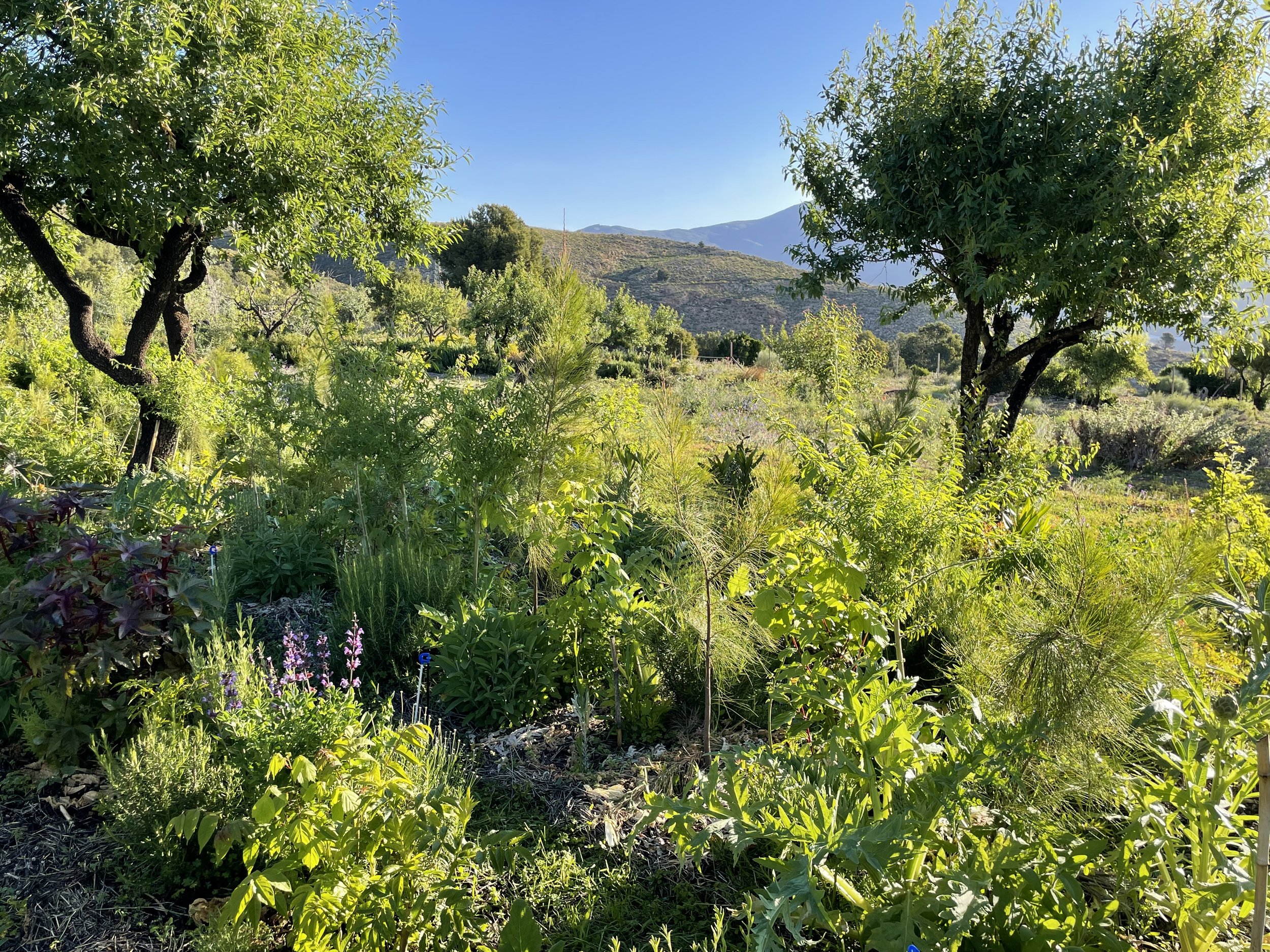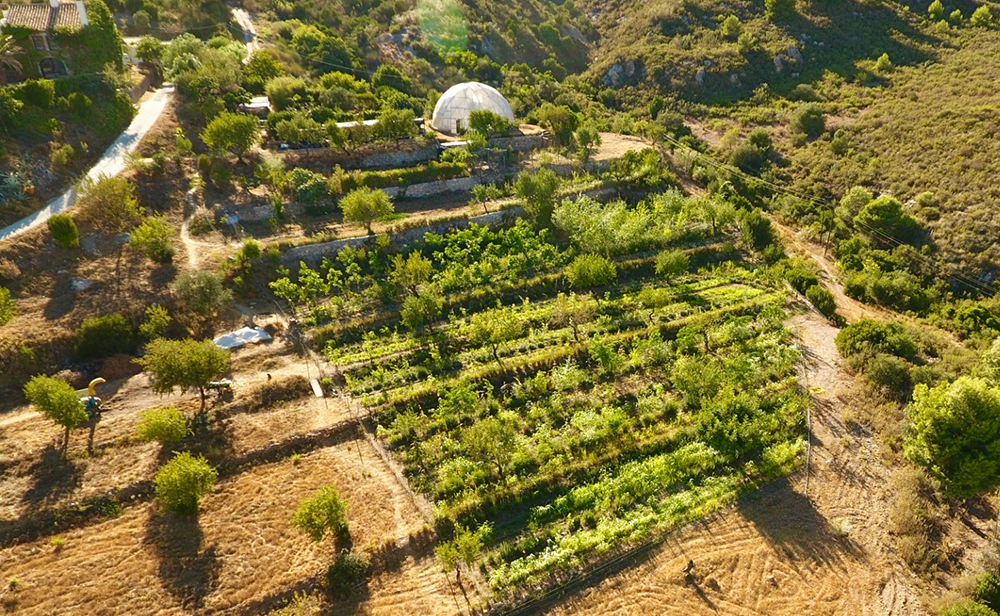Syntropic Farming at la Loma Viva
La Loma Viva is adapting the Syntropic Farming practice of Ernst Gotsch in a Mediterranean/ semi arid climate setting.
We learned about Ernst´s work through the documentary film "Life in Syntorpy” presented at the COP21 in Paris. La Loma Viva was introduced to Ernst in 2016, when he first visited our project. We have been collaborating with him, adapting the practice of Syntropic farming to a Mediterranean climate.
In Brazil, Ernst successfully demonstrated that degraded land can be rehabilitated into abundant, edible forest systems, with multiple ecological benefits. This is a radical new approach to farming, using natural processes to create “agro-ecosystems”. Through the application of this method, we have notable changes to our soil, decreased water inputs and we are creating a veritable oasis for many forms of life in a severely dry and degraded landscape
La Loma are founding members of the TERRA Network, an international group of Syntropic farming practitioners dedicated to providing high-quality education, consulting and mentoring services. See more about TERRA
What is Syntropy?
Many of us are familiar with the term “entropy”, which describes the general understanding of how energy dissipates and become disordered. However, when we study living systems, a complementary phenomena can be observed, which concentrates and complexifies energy. Planet Earth is the ultimate embodiment of this phenomena. We can therefore work with the syntropic force of nature, to increase the complexity and concentrate the energy of living systems.
Syntropic Farming and Syntropic Restoration
Many farms and landscapes have been highly degraded by thousands of years of extractive agriculture, pushing soils and ecosystems beyond their capacity to self regenerate. When working with such environments, we must first focus on building the system's health, and then abundance and production will emerge as a natural overflow of that regenerated system. Syntropic farming is therefore a radical approach to farming, one that asks us to see the land as a living being, with its own intrinsic capacity for regeneration. Our human role is to facilitate intelligent interventions, using different forms and functions of vegetation, to speed up that process.
Multiple layers of densely stacked trees, perennial and annual plants are implemented together, to create forest-like systems, designed to maximise photosynthesis and biomass production. Appropriate species of plants and trees are chosen and planted according to the two main principles of - occupying different strata (Space) and according to their dynamics of succession (Time).
This design, along with selective pruning and management, produces a regenerative farming strategy, creating productive and beautiful agro-ecosystems - yielding multiple useful products such as food, fodder, timber, medicine and much more, along with providing essential ecosystem services, like improving soil conditions, increasing biodiversity and regulating the water cycle. In this way, we are able to transform degraded landscapes into potentially climate changing forested farms with environmental, social and economic benefits.
For more information on Syntropic Farming and the work of Ernst Gotsch go to: http://www.agendagotsch.com
Summer 2021 - 4 years after implementation
Summer 2022 (with major drought and no irrigation)
Initial marking out and set up of the site - Feb 2017
Two months after planting up the site - May 2017
Planting interlines Spring 2020
Summer 2021
New designs 2023/24
New designs 2023/24 Almond terrace retrofit
Aerial view 2019 - 2 years after implementing
Summer perspective of the syntropic area (with no irrigation for 3 years) compared with other drought affected terraces - 2022
syntropic research at la loma viva
We were privileged to be the first case study of syntropic farming to be published in a manual for the UN Food and Agriculture Organisation (FAO) in 2021. Click on the image to read the manual or on the link below to see early stage lab results from soil tests done in 2020 comparing our syntropic research area with neighbouring land.
Here is an excerpt from our case study (Copyright Food and Agriculture Organisation of the United Nations - Recarbonising Global Soils Vol4)
“Syntropic Agriculture presents an opportunity for diversified production, advantageous in reducing the risk of single crop failure and fostering a resilient agricultural system in fluctuating climate change. We have shown that the implementation of SA is able to sequester a significant amount of additional carbon. Increased photosynthesis through densely stacked, stratified plants and trees, plays an important role in reducing atmospheric carbon dioxide (CO2). SA also creates micro-climates (due to the shade and wind protection from trees) to reduce negative weather impacts. Yet probably the most important factor of SA in mitigating climate change is through the reduction of inputs – i.e. limiting fossil fuel consumption of heavy machinery, not using chemical fertilizers and reducing irrigation. With benefits such as these, agriculture can shift from being part of the climate problem to a significant part of the solution (Toensmeier, 2016). The beauty of these systems is that they are able to reduce threats and assist mitigation in an integrated and synergistic way (Duguma et al., 2014) much like natural ecosystems.
An unique aspect of SA is that it has an aesthetic value by creating beauty. Our experience is that SA provides a space for recreation, inspiration and an opportunity to observe and connect to nature, leading to improved quality of life and wellbeing.”
References: Duguma, L.A., Minang, P.A. & van Noordwijk, M. 2014. Climate Change Mitigation and Adaptation in the Land Use Sector: From Complementarity to Synergy. Environmental Management, 54: 420–432. https://doi.org/10.1007/s00267-014-0331-x
Toensmeier, E. 2016. The Carbon Farming Solution. A Global Toolkit for Regenerative Agriculture Practices for Climate Change Mitigation and Food Security. Vermont. Chelsea Green.



















